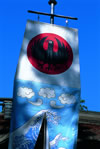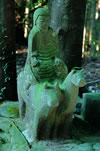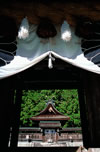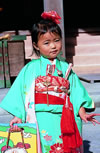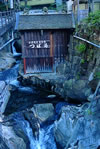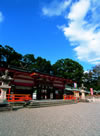|
|
 |
(1) |
The banner at Kumano Hongu Taisha Shrine depicts the Yata-garasu Crow, a symbol of the three Kumano shrines. The mythical three-legged crow has also become the symbol of the Japan Football (Soccer) Association. |
|
|
|
 |
(2) |
Stone statue of a boy riding an ox and horse, beside the Nakahe-ji Road. Height, about 40 cm. The boy is said to be Emperor Kazan in his youth. The emperor often received religious training at Kumano, around the end of the 10th century. |
|
|
|
 |
(3) |
The view from Fushiogami Oji tells us why this region is called the "3,600 Mountains of Kumano." The former site of Kumano Hongu Taisha Shrine is in the valley, mid-photo. |
|
| |
 |
(4) |
Kumano Hongu Taisha Shrine today. |
|
|
|
 |
(5)
|
This child is dressed up to visit the shrine during the 7-5-3 Festival, which is held on November 15. People pray that the children will grow up healthy. |
|
|
|
 |
(6) |
Years ago, travelers would rest their weary legs at places like this old teahouse on the Nakahe-ji Road. |
|
|
|
 |
(7) |
Tsubo-yu, a hot spring near Kumano Hongu Taisha Shrine. Pilgrims coming to Kumano used to bathe here to
purify themselves. |
|
|
|
 |
(8) |
Tourists listening to every word of an explanation given by Wadama Yoshimi, a member of the Hongu-cho Kataribe no Kai.
|
|
|
|
 |
(9) |
Parts of Kumano Hayatama Taisha Shrine are painted a bright red, contrasting with the blue sky and green trees. |
|
| |
 |
(10) |
The city of Shingu, seen from Kamikura Shrine. |
